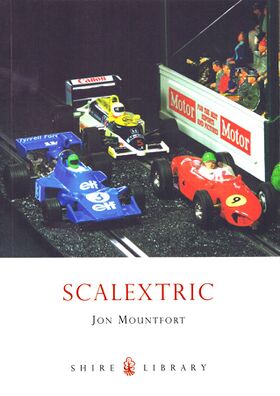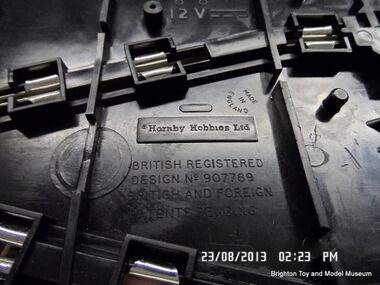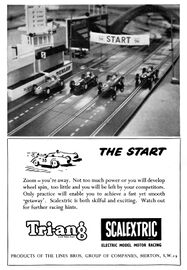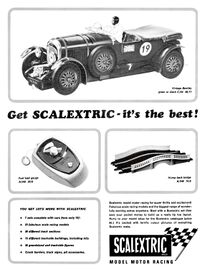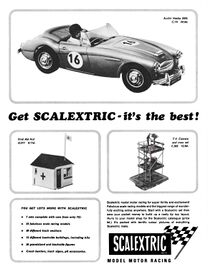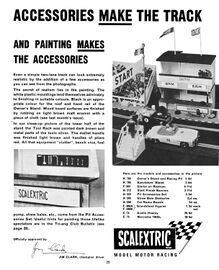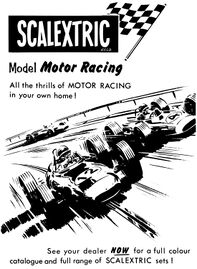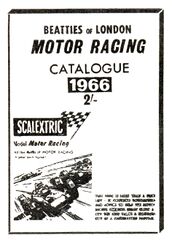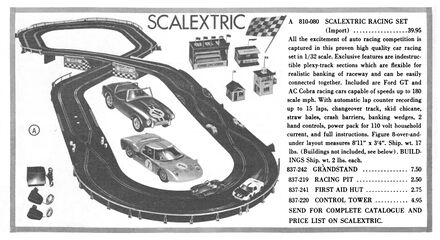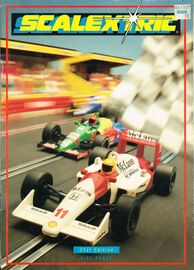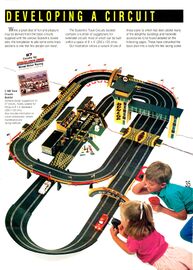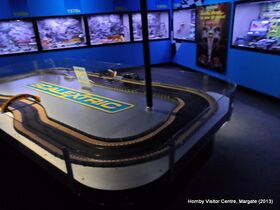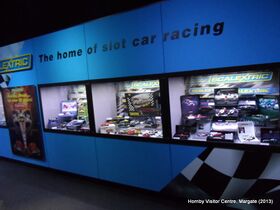Category:Scalextric
| Slotcar systems |
|---|
Scalextric |
| 1957 - |
| Airfix/MRRC | Champion | Circuit 24 | Cox Slot Racers | Formula 152 | Highways | Matchbox Motorway | Minic Motorways | Monogram | Revell Model Racer | Scale Raceway Models (SRM) | Scalextric | VIP Raceways |
~1957: Scalextric Model Motor Racing Manual [image info]
~1957: Scalextric slotcar internals, showing motor and gimbal [image info]
1960: Catalogue cover [image info]
1965: Artwork in Tri-ang Magazine [image info]
1965: Scalextric racing [image info]
1966: "Scalextric Model Motor racing, officially approved by Jim Clark, World Champion Driver" [image info]
1966: "Only Scalextric gives you eight lane racing" [image info]
"Scalextric", Jon Mountfort, Shire Library [image info]
Underside of a section of modern Scalextric track, showing the Hornby Hobbies mark [image info]
Scalextric is a classic British slot-car racing system originally created by Minimodels Ltd. in 1957. In the UK "Scalextric" became synonymous with slotcar systems in the same way that "Hoover" became synonymous with vacuum cleaners (so that people would talk about "a hoover" even if it was a vacuum cleaner made by someone else), and when we talk to people about slotcars they often say things to us like: "Oh, I loved my Scalextric set. Mine was made by Airfix ...".
Branding
Minimodels' main toy car ranges had been the clockwork Scalex, and Startex, and when they launched their new 1957 slotcar system, the branding was an extension of their earlier ranges, a sort of "electric Scalex" ("Scalex" + "electric" = "Scalextric"). The result was a sufficiently unique brandname that it tended to eclipse many of the other brands that had boring literal names with numbers in, like the 1:52 scale "Formula 152". Even though almost nobody knew what it stood for, "Scalextric" was the name that everybody remembered ... even if most people seemed to misremember and mispronounce it as "Scalectrix" (which would actually have been a more natural brandname, with the "X" at the end rather than in the middle).
Minimodels were sold to Lines Brothers in late 1958, after which the product carried Lines Brothers/Triang branding, wither the made by "Minimodels Ltd." tagline eventually being replaced in advertising by 1960 with "Tri-ang Scalextric: Products Of The Lines Brothers Group Of Companies".
Origins
The UK slotcar industry is reckoned to have its origins in the mid-1950s with the intersection of three companies – Minimodels Ltd (Scalex), Victory Industries, and MRRC Ltd. – with the "rail" car racing enthusiast community and with Model Maker magazine, which published some influential articles that helped establish the basics of modern slotcar racing (modular track, 1:32 scale, and so on), but in the context of rail racing, where there was a raised insulated guide rail running along the centre of each lane, with a conductor strip or wire embedded in each side.
Originally an enthusiast hobby relying heavily on "homebrew" cars, MRRC then put together the metal-shelled Scalex cars made by Minimodels with the Mighty Midget motors made by Victory to produce a reliable compact electrical car that ran well from external power supplied by track pickups. The idea of replacing the two-conductor rail with a two-conductor slot then represented a "lightbulb moment" at which point everyone realised that this was now the basis of a good commercial product, and all three companies started offering ready-to-run slotcar systems with modular ready-made track:
- MRRC became part of Airfix to produce Airfix Motor Racing (later Airfix MRRC, and then just MRRC)
- Victory Industries produced VIP Raceways
- Minimodels produced Scalextric, and were promptly bought by Lines Brothers (making Scalextric now a Tri-ang product)
Concept
The genius of Scalextric (and the reason why the brand became a national hit) was that it turned the worst aspects of the system - variation in car characteristics, awkward and difficult controls, and a tendency for the car to fly off the track if you went too fast - into features, difficulties that a player had to overcome when competing with another racer.
While a model train system with jerky speed controls that had a tendency to crash the train if you went too fast would be considered a failure, in the context of car racing, the constant threat of crashing simply added to the excitement and realism, and the difficulty of getting the car's speed just right using the crude controllers also added an element of skill to what might otherwise have been a fairly mundane game.
Construction
The "classic" Scalextric track consisted of short, wide, sections of rubber or black plastic roadway that clipped together and included a pair of slots with metal conductors, which allowed two cars to run side-by-side. Cars had electric motors powered via pickups that protruded into the slots, and the system came with a pair of hand-held "trigger" speed controllers.
Since the cars ran along the slotted paths, there was no steering, the element of skill in racing Scalextric cars was to judge just how fast you could make a car go before it flew off the track - as with "proper" racing cars, the maximum safe speed that you could achieve on the straights was faster than on the curves.
Development
The original Scalextric cars were metal, but this changed to moulded plastic after the brand was sold to Triang, who had the clout to market the toy properly and produce it in large quantities. Later variations included Super124 (which was 1:24 scale rather than 1:32), MicroScalextric (1:64 scale), and versions with a digital control system that allowed cars to share tracks and switch between tracks remotely.
~1957 manual text:
INTRODUCTION
5 MINUTES after you begin unpacking your 'SCALEXTRIC' Kit you will be ready for the start of the first race of your first race meeting. For all you have to do is put the track sections together, connect up your control unit to the rails and battery (or transformer), place the cars on their track and everything is ready.
You will find that the cars really do race, and that you will have to control them round the bends. That's where your driving skill comes in, for along the straights you will attain a scale speed of about 130 m.p.h. which is too fast for cornering. So remember to cut power as you approach a bend — especially if you are on the inside position — and then give your car full power again as you go around and in to the next straight.
Handicaps? On an oval track the inside car is automatically handicapped on the bends as it cannot take them at the same fast speed as the outer, but as it has the advantage in other ways the cars are quite evenly matched. You can, if you wish, work out your own handicap formula for each race.
One of the many big attractions of your 'SCALEXTRIC' Set is the "Plexytrack". Pliable and flexible, and virtually indestructible,
you can do lots of different things with it, such as building gradients and banking curves, and so vary your basic circuit for each race meeting. You can also use it as ordinary roadway and vehicles, in conjunction with model towns, railways and vehicles.
SOME PRACTICAL POINTERS
You are in good company once you acquire a SCALEXTRIC KIT for some of the most famous of our racing drivers enjoy nothing more than a miniature "dice" in their own drawing rooms when their fullsize thrills of the day before come alive again for them. How much you enjoy your kit depends on you: we provide the goods, but you use them. The cars really do race, and it is a clever driver who can keep one going lap after lap without "running out of road" — just like the real thing! Scale speeds are equal to nearly 180 m.p.h., so that corners must be treated with respect, following the old racing maxim of "slow in, fast out."
After a little while you will get the knack of using the amazing slide, which is uncontrolled, and turning it into drift, which is controlled sliding, and a joy to watch performed by such masters as Fangio and Moss. By judicious handling of your speed control button you, too, can achieve, in model size, smooth fast cornering in the maestros' pattern.
Track Building Hints
As a general rule, inner and outer lanes are equal in a figure of eight circuit, provided that the two halves of the figure have the same number of sections in them, that is to say, each car runs half a lap on the inside and half a lap on the outside track. But when building up more complicated circuits—you can imitate in miniature some of the actual fullsize circuits you have seen such as Aintree, Goodwood or Silverstone—watch this point and add an extra curve to even things out a bit. Track geometry is simple. The basic circle contains eight pieces, and, usually, in working out a track full circles or half circles will be required or the ends just will not meet!
Sometimes, however, you can get over this difficulty by using short straight section S.S.I. These are slightly under a quarter of a full straight in length, and a combination of these will allow you to overcome pretty well any problem. The latest "inner curves" are suitable for four lane will help in building really tricky courses.
The pliable flexible nature of the track material also allows you to bank up corners, either to get faster speeds at a particular corner, or to build an all-banked circuit on the lines of America's Indianapolis. A book slipped under the corner will give an idea of possibilities, and more permanent banking can be made up in wood if the idea appeals.
Power
The battery box is intended for three Ever-Ready No. 126 bell batteries of 4kv. each, but, please, not just any old batteries! Batteries like eggs do not keep for ever in stock so try to buy them from a firm doing a big turnover so that yours are fresh. Testing them on sale with a torch bulb is no guarantee they are fresh, ask the dealer to check the voltage with his testmeter under load, that is to say drawing current—no reputable firm will mind—and you will be sure of getting the maximum useful life out of them.
A transformer/rectifier must be used if you decide to use mains electricity. For the best results each car requires 1 amp., therefore, for two-lane racing you will need a 2 amp. transformer/rectifier. A 2 amp. "Smoothflow" unit is available for this purpose, from your Tri-ang Scalextric dealer.
SCALEXTRIC makes new friends!
Friends will be quick to call when the news gets round that you have a Scalextric kit. We have yet to meet anyone who could resist these little cars, so you will not want for racing opponents. If two or three owners can get together locally then a pooling of track resources should lead to some pretty exciting circuits. All kinds of races can be organised, handicaps, team races, regularity tests, hillclimbs, speed dashes and so on, but remember that, like fullsize cars, no motor will go flat out for ever — so rest cars now and then if there is any sign of overheating. (A spare car is a good thing to have, then fun can continue unabated — anyway, you will almost certainly be tempted by some of the new designs coming out!)
This friendship amongst Scalextric Owners extends even further. We publish SCALEXTRIC BULLETINS, which are sent free of charge to all registered owners who have sent in their registration cards. Here owners can read of the latest additions, hints and tips on Scalextric operation, views and news of other owners, and the many exciting treats we have in store for our Owners. We welcome you all to our Owners' Club, we certainly have no wish to say good-bye when we have only just met, so remember the Scalextric manufacturers, and the Editor of SCALEXTRIC BULLETIN, are always pleased to hear of your successes, and try to solve your special problems.
1959 text:
Scalextric sets are all complete with track, controller, etc., and two cars, and are capable of expansion by the addition of extra lengths of track. Countless variations of layout can be tried. The special Plexy-track is flexible to allow for banking of layouts for speed, or a hill climb course with tricky bends can easily be assembled.
Scalextric needs skill to operate to the full, though many a youngster can show his father a clean pair of rear wheels. Too much speed and cars go into vicious slides – just like the real thing: with practice this slide can be tamed to a controlled drift worthy of Fangio at his best – you'll be amazed.
All new owners of sets are able to join, free of charge, the Scalextric Owner's Club and receive the "Scalextric Bulletin" at regular intervals, with information of our activities, new additions to our range and news from Scalextric Clubs far and wide.
Miscellaneous 1960s advertising
Third-party adverts and catalogue entries
Longevity:
While other more "advanced" competitors to Scalextric, with more sophisticated "serious" features, more advanced engineering, and smaller scales either became niche "club" or "enthusiast only" brands or disappeared altogether, "simple" Scalextric is still going.
When we look at the 1990 catalogue (above), not a heck of a lot has changed from the 1960 edition. While the standard Scalextric range was arguably nothing exceptional, the fact that it was simple, straightforward and didn't obviously have lots of strange and bewildering features that many people wouldn't understand ("What's Ackerman steering? Do I need it? Does it break easily?") meant that it became the default thing to buy if you just wanted to get the family a simple slotcar system that they could all play with over the Christmas holidays.
No other toy can give the pleasure and satisfaction of driving a high speed car round a circuit representative of Silverstone, or anywhere else you prefer, in hot competition with a similar car, all in your own home, and then going on to win.
The key elements of Scalextric are sturdy realistic electric cars controlled by sensitive pistol grip hand throttles and running on a resilient track system that can be laid down and taken up readily.
Boxed sets of Scalextric come complete with a power pack which converts the house mains electricity supply down to a safe 12 volts.
Skilled Scalextric drivers vary in age between about 4 and 80 years. The requirements for becoming a champion are similar to those of real Grand Prix and Rally drivers, namely practice, determination and a touch of luck.
The cars are strongly built and beautifully decorated. Being 1/32 scale, each around 5" long, they are large enough for anyone to handle comfortably.
They are designed to be raced not just admired, and can stand up to the rough and tumble of every day use.
Enjoy looking through this catalogue Scalextric is meant for you!
— , Hornby Hobbies, , Scalextric catalogue, 31st edition, , 1990
The key image is probably the picture on the right, of a pair of young children playing with a Scalextric circuit. By presenting the system as sturdy and suitable for ages from "about 4 and 80 years", Scalextric positioned itself as the default slotcar system that could be used by anyone ("Scalextric is meant for you!"). Given that the product range is still around in 2019, The strategy obviously worked.
Scalextric in museums
While we'd love to have a Scalextric track track set up, the space limitations in our museum, combined with the system's large 1:32-scale, means that it would just take up too much display space.
However, the last time we visited, the Hornby Visitor Centre in Margate had a whole dedicated Scalextric room with wall displays showing the history of the system, and had a track that visitors could play with.
Further reading
- Rod Green, Scalextric: The story of the world's favourite model racing cars, (Harper Collins, 2001) ISBN 0007657811
- Jon Mountfort, Scalextric (Shire Library, 2009), ISBN 0747807477
- James May with Ian Harrison, James May's Toy Stories (Anova, 2009) ISBN 1844861074 pages 170-205
External links
Subcategories
This category has the following 6 subcategories, out of 6 total.
A
- Scalextric accessories (5 F)
C
R
- Scalextric Race-Tuned (3 P, 19 F)
S
- Scalex (1 P, 3 F)
- Scalextric sets (1 F)
T
- Scalextric track (5 F)
Pages in category ‘Scalextric’
The following 10 pages are in this category, out of 10 total.
Media in category ‘Scalextric’
The following 75 files are in this category, out of 75 total.
- AC Cobra Sports, Scalextric Race-Tuned C-78 (Hobbies 1968).jpg 1,484 × 978; 129 KB
- Accessories Make The Track, Scalextric (TriangMag 1965-07).jpg 2,429 × 3,000; 2.03 MB
- Alfa Romeo 1933 Vintage Road Racer, Scalextric C-65 (Hobbies 1968).jpg 1,375 × 864; 116 KB
- Aston Martin GT, Scalextric C-68 (Hobbies 1968).jpg 1,635 × 963; 150 KB
- Austin Healey 3000 Sports, Scalextric C-74 (Hobbies 1968).jpg 1,525 × 939; 130 KB
- Austin Healey Sports, Race-Tuned Scalextric C-93 (Hobbies 1968).jpg 1,485 × 865; 122 KB
- Austin Mini-Cooper, Scalextric C-76 (Hobbies 1968).jpg 1,272 × 953; 118 KB
- Banking and Bridging, Scalextric (ScalextricCat 1960-01).jpg 3,000 × 1,831; 2.73 MB
- Beatties Motor Racing Catalogue 1966, Scalextric lineart (MM 1966-10).jpg 941 × 1,312; 516 KB
- Bentley 1929 Vintage Road Racer, Scalextric C-64 (Hobbies 1968).jpg 1,368 × 853; 117 KB
- BRM Formula 1, Scalextric C-85 (Hobbies 1968).jpg 1,347 × 819; 95 KB
- BRM Grand Prix, Scalextric Race-Tuned C-89 (Hobbies 1968).jpg 1,398 × 847; 108 KB
- Bugatti 1934 Vintage Grand Prix, Scalextric Race-Tuned C-95 (Hobbies 1968).jpg 1,575 × 913; 122 KB
- Catalogue cover, Scalextric (Scalextric31 1990).jpg 1,149 × 1,600; 273 KB
- Controller, Scalextric A-256 (Hobbies 1968).jpg 1,571 × 775; 97 KB
- Cooper Formula 1, Scalextric C-81 (Hobbies 1968).jpg 1,435 × 860; 99 KB
- Cooper Grand Prix, Scalextric Race-Tuned C-88 (Hobbies 1968).jpg 1,384 × 840; 99 KB
- D Type Jaguar, Competition, Scalextric Race-Tuned C-91 (Hobbies 1968).jpg 1,484 × 921; 122 KB
- Developing a Circuit, Scalextric (Scalextric31 1990).jpg 1,145 × 1,600; 350 KB
- Ferrari Grand Prix, Scalextric Race-Tuned C-90 (Hobbies 1968).jpg 1,343 × 808; 97 KB
- Ferrari GT, Scalextric C-69 (Hobbies 1968).jpg 1,467 × 869; 125 KB
- Ford Grand Touring, Scalextric Race-Tuned C-77 (Hobbies 1968).jpg 1,475 × 903; 113 KB
- Get Scalextric - Its the Best (TriangMag 1965-05).jpg 2,315 × 3,000; 1.53 MB
- Get Scalextric - Its the Best(TriangMag 1965-03).jpg 2,243 × 3,000; 2.4 MB
- Get Scalextric - Its the Best(TriangMag 1965-04).jpg 2,282 × 3,000; 1.79 MB
- Go-Kart, Scalextric K-1 (Hobbies 1968).jpg 1,021 × 845; 73 KB
- Hand Controller for Race-Tuned cars, Scalextric A-262 (Hobbies 1968).jpg 1,571 × 1,107; 130 KB
- Humpback Bridge, Scalextric advert (MM 1961-02).jpg 2,461 × 3,000; 1.01 MB
- Hurricane Combination, Scalextric B-2 (Hobbies 1968).jpg 1,153 × 774; 81 KB
- James Mays Toy Stories, cover and spine (ISBN 9781844861071).jpg 1,451 × 1,600; 1.39 MB
- Lotus Formula 1, Scalextric C-82 (Hobbies 1968).jpg 1,303 × 807; 95 KB
- Lotus Grand Prix, Scalextric C-54 (Hobbies 1968).jpg 1,375 × 859; 113 KB
- Mercedes 190 SL Sports, Scalextric C-75 (Hobbies 1968).jpg 1,517 × 949; 125 KB
- Mercedes Sports, Scalextric Race-Tuned C-94 (Hobbies 1968).jpg 1,560 × 892; 129 KB
- Offenhauser Front Engine, Scalextric Race-Tuned C-79 (Hobbies 1968).jpg 1,489 × 965; 119 KB
- Offenhauser Rear Engine, Scalextric Race-Tuned C-80 (Hobbies 1968).jpg 1,428 × 908; 116 KB
- Only Scalextric gives you 8 lane racing, advert (MM 1966-12).jpg 2,319 × 3,000; 1,017 KB
- Porsche Competition, Scalextric Race-Tuned C-92 (Hobbies 1968).jpg 1,490 × 860; 122 KB
- Porsche Formula 1, Scalextric C-86 (Hobbies 1968).jpg 1,257 × 792; 90 KB
- Race Tuned range by Scalextric, advert (MM 1966-10).jpg 2,277 × 3,000; 2.57 MB
- Scalex and Startex, Minimodels Ltd (GaT 1956).jpg 1,024 × 1,600; 264 KB
- Scalex logo 1956.jpg 476 × 256; 15 KB
- Scalextric cars range, racing and race-tuned (Hobbies 1968).jpg 1,200 × 784; 539 KB
- Scalextric Catalogue, front cover (ScalextricCat 1960-01).jpg 2,274 × 3,000; 3.52 MB
- Scalextric Electric Model Motor Racing, logo (1960).jpg 1,600 × 797; 217 KB
- Scalextric Electric Racing Game (Schwarz 1962).jpg 3,000 × 1,447; 1.93 MB
- Scalextric extensions, artwork (TriangMag 1965-06).jpg 3,000 × 2,262; 3.68 MB
- Scalextric Grandstand kit, assembled and painted (MM 1966-10).jpg 3,000 × 1,907; 2.19 MB
- Scalextric Model Motor Racing (MM 1967-07).jpg 2,305 × 3,000; 1.86 MB
- Scalextric Model Motor Racing, advert (MM 1965-12).jpg 2,195 × 3,000; 583 KB
- Scalextric Model Motor Racing, Jim Clark (MM 1966-10).jpg 2,289 × 3,000; 694 KB
- Scalextric Motor Racing Manual, cover (SxcMRMan 1957).jpg 3,000 × 2,205; 4.32 MB
- Scalextric Race Tuned, logo (1966).jpg 1,120 × 950; 205 KB
- Scalextric racing layout (MM 1965-10).jpg 2,500 × 1,875; 964 KB
- Scalextric Racing Set, import (Schwarz 1967).jpg 3,000 × 1,637; 2.4 MB
- Scalextric Room, Hornby Visitor Centre, Margate, 02 (HVC 2013).jpg 800 × 600; 237 KB
- Scalextric Room, Hornby Visitor Centre, Margate, 03 (HVC 2013).jpg 800 × 600; 255 KB
- Scalextric Set, Hornby Visitor Centre, Margate (HVC 2013).jpg 800 × 600; 259 KB
- Scalextric track, underside.jpg 2,000 × 1,500; 1.36 MB
- Scalextric, Jon Mountfort, 0747807477 (Shire Library).jpg 849 × 1,200; 137 KB
- Slotcar internals, Scalextric (SxcMRMan 1957).jpg 2,857 × 2,322; 1.31 MB
- Smoothflow Power Supply, leaflet (Minimodels).jpg 1,523 × 2,200; 349 KB
- Special Scalextric Racing Set, Gamages (RM 1962-12).jpg 2,173 × 1,363; 1.11 MB
- Standard Set Layouts, Scalextric (ScalextricCat 1960-01).jpg 3,000 × 2,318; 2.99 MB
- Sunbeam Tiger Sports, Scalextric Race-Tuned C-83 (Hobbies 1968).jpg 1,479 × 892; 120 KB
- The Accepted Standard, Scalextric advert (MM 1965-10).jpg 2,308 × 3,000; 647 KB
- The Chicane, Scalextric advert (MM 1961-05).jpg 2,429 × 3,000; 913 KB
- The Start, Scalextric advert (MM 1960-09).jpg 2,079 × 3,000; 986 KB
- The Track, Scalextric (Scalextric31 1990).jpg 1,600 × 1,125; 360 KB
- Track Sections, Scalextric (ScalextricCat 1960-01).jpg 2,141 × 3,000; 4.32 MB
- Trackside Buildings and Accessories, Scalextric (ScalextricCat 1960-01).jpg 2,138 × 3,000; 4.69 MB
- Triumph TR4A, Scalextric Race-Tuned C-84 (Hobbies 1968).jpg 1,474 × 899; 124 KB
- Typhoon Combination, Scalextric B-1 (Hobbies 1968).jpg 1,118 × 799; 81 KB
- Vanwall Grand Prix, Scalextric Race-Tuned C-87 (Hobbies 1968).jpg 1,400 × 881; 110 KB








